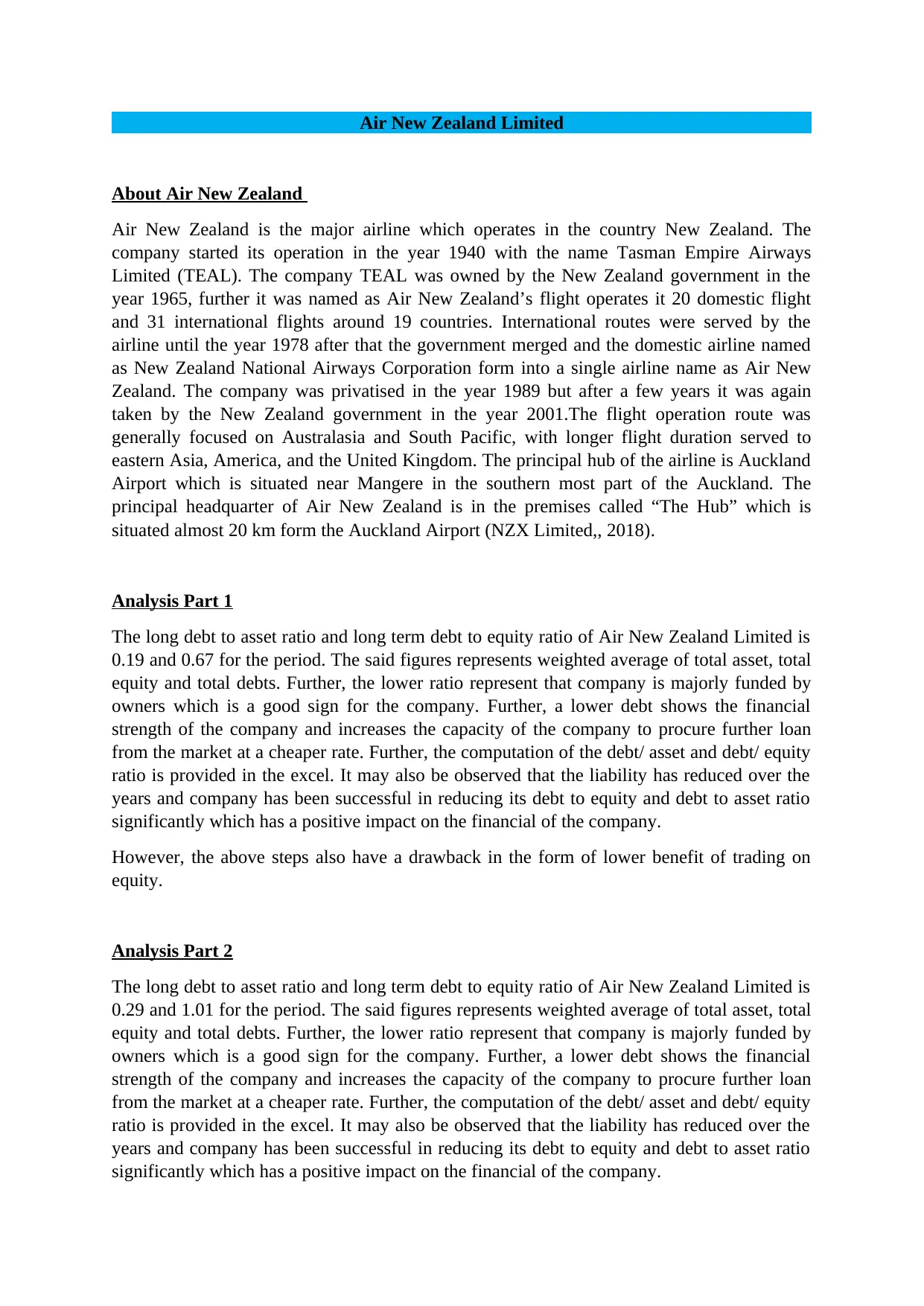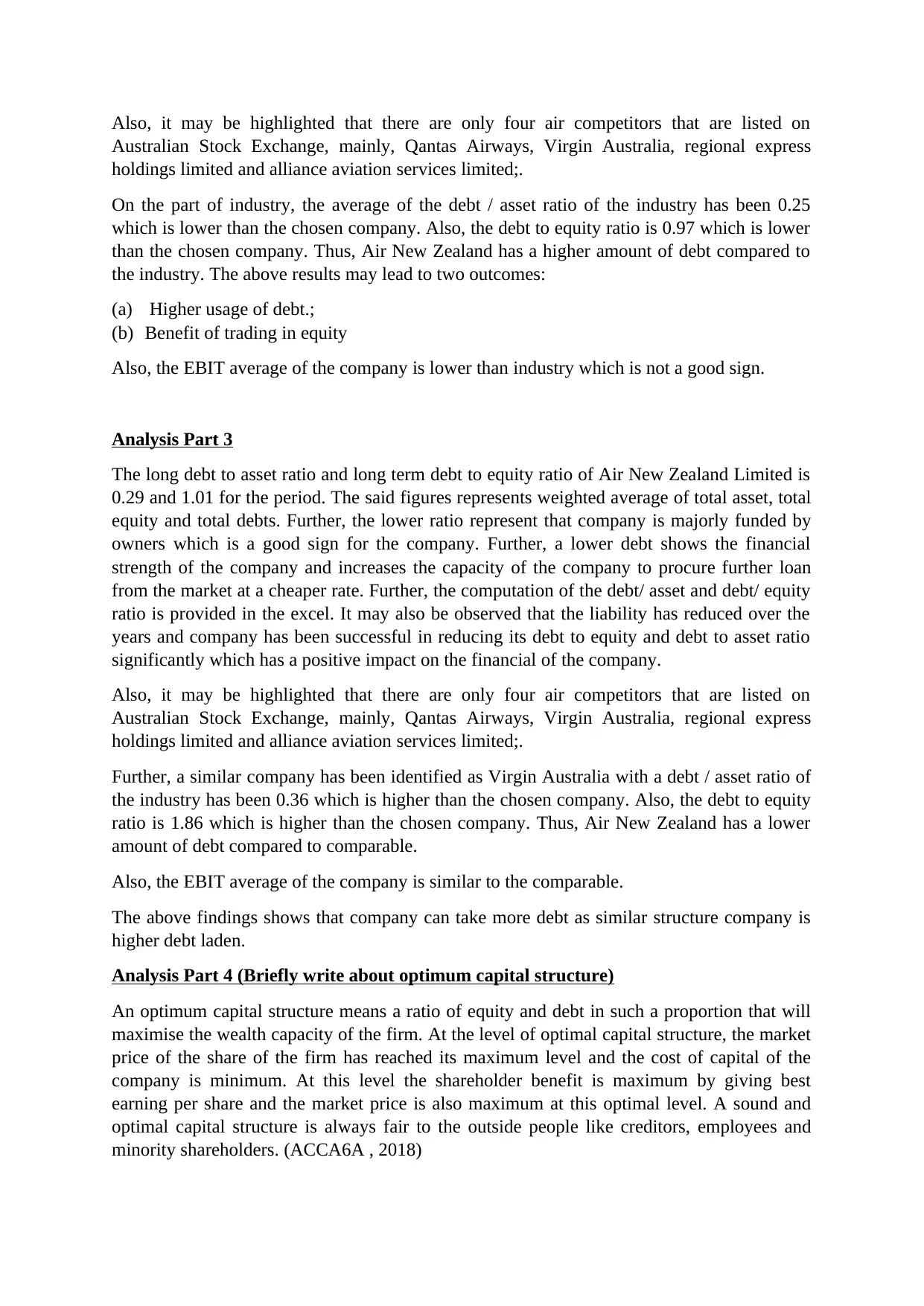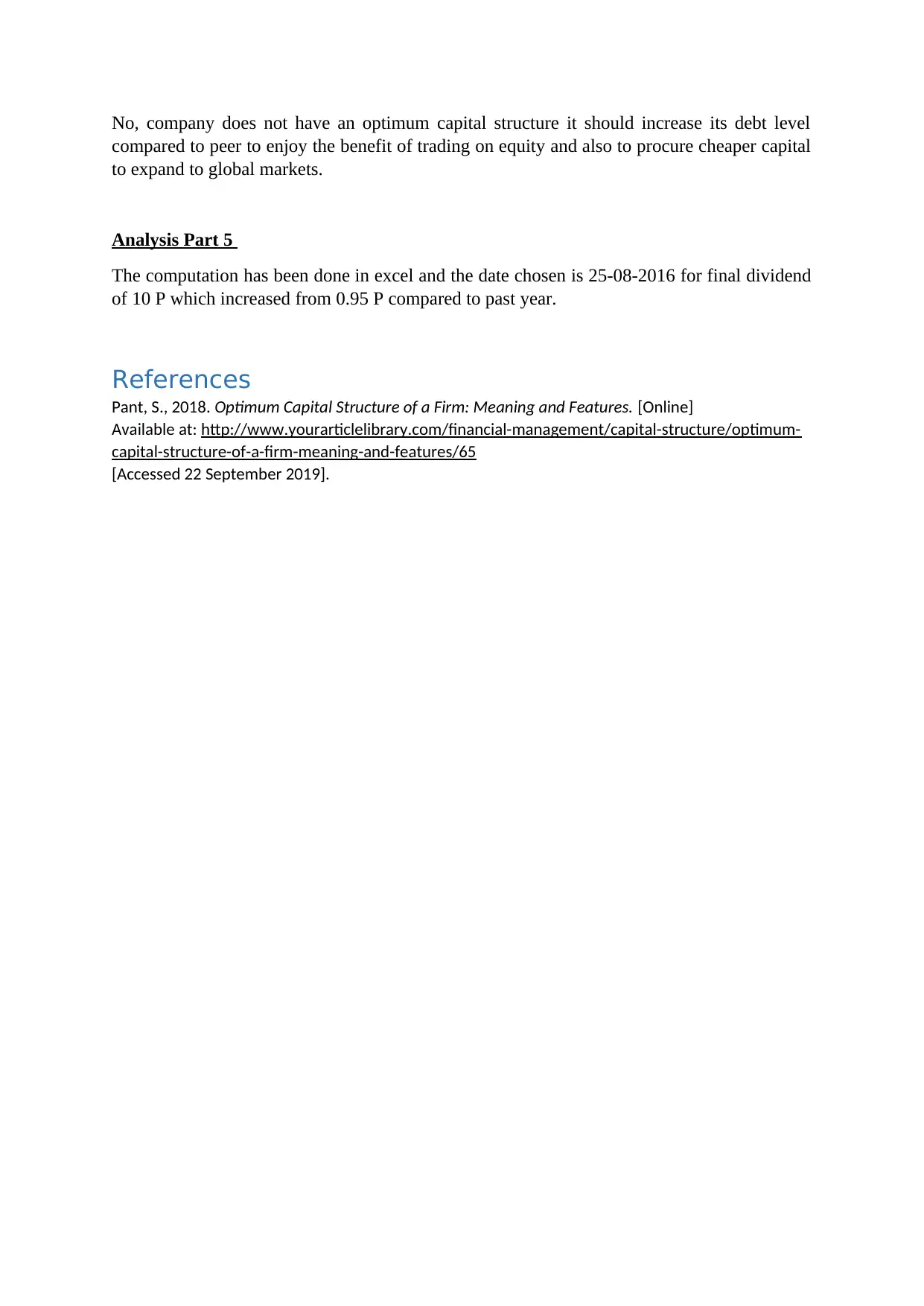Financial Analysis Report: Air New Zealand Limited - Debt & Equity
VerifiedAdded on 2022/10/19
|3
|1227
|13
Report
AI Summary
This report presents a financial analysis of Air New Zealand Limited, examining its performance from 2014 to 2018. The analysis focuses on key financial ratios, including debt-to-asset and debt-to-equity ratios, comparing them to industry averages and a similar company, Virgin Australia. The report highlights Air New Zealand's financial strength, particularly its lower debt levels compared to some competitors, and discusses the implications of its capital structure. It includes calculations of debt ratios, EBIT, and dividend information, referencing relevant financial literature. The report also addresses the concept of an optimal capital structure and provides insights into the company's dividend policy and overall financial health, supported by data analysis and industry comparisons. The analysis suggests that the company could potentially increase its debt to leverage the benefits of trading on equity.

Air New Zealand Limited
About Air New Zealand
Air New Zealand is the major airline which operates in the country New Zealand. The
company started its operation in the year 1940 with the name Tasman Empire Airways
Limited (TEAL). The company TEAL was owned by the New Zealand government in the
year 1965, further it was named as Air New Zealand’s flight operates it 20 domestic flight
and 31 international flights around 19 countries. International routes were served by the
airline until the year 1978 after that the government merged and the domestic airline named
as New Zealand National Airways Corporation form into a single airline name as Air New
Zealand. The company was privatised in the year 1989 but after a few years it was again
taken by the New Zealand government in the year 2001.The flight operation route was
generally focused on Australasia and South Pacific, with longer flight duration served to
eastern Asia, America, and the United Kingdom. The principal hub of the airline is Auckland
Airport which is situated near Mangere in the southern most part of the Auckland. The
principal headquarter of Air New Zealand is in the premises called “The Hub” which is
situated almost 20 km form the Auckland Airport (NZX Limited,, 2018).
Analysis Part 1
The long debt to asset ratio and long term debt to equity ratio of Air New Zealand Limited is
0.19 and 0.67 for the period. The said figures represents weighted average of total asset, total
equity and total debts. Further, the lower ratio represent that company is majorly funded by
owners which is a good sign for the company. Further, a lower debt shows the financial
strength of the company and increases the capacity of the company to procure further loan
from the market at a cheaper rate. Further, the computation of the debt/ asset and debt/ equity
ratio is provided in the excel. It may also be observed that the liability has reduced over the
years and company has been successful in reducing its debt to equity and debt to asset ratio
significantly which has a positive impact on the financial of the company.
However, the above steps also have a drawback in the form of lower benefit of trading on
equity.
Analysis Part 2
The long debt to asset ratio and long term debt to equity ratio of Air New Zealand Limited is
0.29 and 1.01 for the period. The said figures represents weighted average of total asset, total
equity and total debts. Further, the lower ratio represent that company is majorly funded by
owners which is a good sign for the company. Further, a lower debt shows the financial
strength of the company and increases the capacity of the company to procure further loan
from the market at a cheaper rate. Further, the computation of the debt/ asset and debt/ equity
ratio is provided in the excel. It may also be observed that the liability has reduced over the
years and company has been successful in reducing its debt to equity and debt to asset ratio
significantly which has a positive impact on the financial of the company.
About Air New Zealand
Air New Zealand is the major airline which operates in the country New Zealand. The
company started its operation in the year 1940 with the name Tasman Empire Airways
Limited (TEAL). The company TEAL was owned by the New Zealand government in the
year 1965, further it was named as Air New Zealand’s flight operates it 20 domestic flight
and 31 international flights around 19 countries. International routes were served by the
airline until the year 1978 after that the government merged and the domestic airline named
as New Zealand National Airways Corporation form into a single airline name as Air New
Zealand. The company was privatised in the year 1989 but after a few years it was again
taken by the New Zealand government in the year 2001.The flight operation route was
generally focused on Australasia and South Pacific, with longer flight duration served to
eastern Asia, America, and the United Kingdom. The principal hub of the airline is Auckland
Airport which is situated near Mangere in the southern most part of the Auckland. The
principal headquarter of Air New Zealand is in the premises called “The Hub” which is
situated almost 20 km form the Auckland Airport (NZX Limited,, 2018).
Analysis Part 1
The long debt to asset ratio and long term debt to equity ratio of Air New Zealand Limited is
0.19 and 0.67 for the period. The said figures represents weighted average of total asset, total
equity and total debts. Further, the lower ratio represent that company is majorly funded by
owners which is a good sign for the company. Further, a lower debt shows the financial
strength of the company and increases the capacity of the company to procure further loan
from the market at a cheaper rate. Further, the computation of the debt/ asset and debt/ equity
ratio is provided in the excel. It may also be observed that the liability has reduced over the
years and company has been successful in reducing its debt to equity and debt to asset ratio
significantly which has a positive impact on the financial of the company.
However, the above steps also have a drawback in the form of lower benefit of trading on
equity.
Analysis Part 2
The long debt to asset ratio and long term debt to equity ratio of Air New Zealand Limited is
0.29 and 1.01 for the period. The said figures represents weighted average of total asset, total
equity and total debts. Further, the lower ratio represent that company is majorly funded by
owners which is a good sign for the company. Further, a lower debt shows the financial
strength of the company and increases the capacity of the company to procure further loan
from the market at a cheaper rate. Further, the computation of the debt/ asset and debt/ equity
ratio is provided in the excel. It may also be observed that the liability has reduced over the
years and company has been successful in reducing its debt to equity and debt to asset ratio
significantly which has a positive impact on the financial of the company.
Paraphrase This Document
Need a fresh take? Get an instant paraphrase of this document with our AI Paraphraser

Also, it may be highlighted that there are only four air competitors that are listed on
Australian Stock Exchange, mainly, Qantas Airways, Virgin Australia, regional express
holdings limited and alliance aviation services limited;.
On the part of industry, the average of the debt / asset ratio of the industry has been 0.25
which is lower than the chosen company. Also, the debt to equity ratio is 0.97 which is lower
than the chosen company. Thus, Air New Zealand has a higher amount of debt compared to
the industry. The above results may lead to two outcomes:
(a) Higher usage of debt.;
(b) Benefit of trading in equity
Also, the EBIT average of the company is lower than industry which is not a good sign.
Analysis Part 3
The long debt to asset ratio and long term debt to equity ratio of Air New Zealand Limited is
0.29 and 1.01 for the period. The said figures represents weighted average of total asset, total
equity and total debts. Further, the lower ratio represent that company is majorly funded by
owners which is a good sign for the company. Further, a lower debt shows the financial
strength of the company and increases the capacity of the company to procure further loan
from the market at a cheaper rate. Further, the computation of the debt/ asset and debt/ equity
ratio is provided in the excel. It may also be observed that the liability has reduced over the
years and company has been successful in reducing its debt to equity and debt to asset ratio
significantly which has a positive impact on the financial of the company.
Also, it may be highlighted that there are only four air competitors that are listed on
Australian Stock Exchange, mainly, Qantas Airways, Virgin Australia, regional express
holdings limited and alliance aviation services limited;.
Further, a similar company has been identified as Virgin Australia with a debt / asset ratio of
the industry has been 0.36 which is higher than the chosen company. Also, the debt to equity
ratio is 1.86 which is higher than the chosen company. Thus, Air New Zealand has a lower
amount of debt compared to comparable.
Also, the EBIT average of the company is similar to the comparable.
The above findings shows that company can take more debt as similar structure company is
higher debt laden.
Analysis Part 4 (Briefly write about optimum capital structure)
An optimum capital structure means a ratio of equity and debt in such a proportion that will
maximise the wealth capacity of the firm. At the level of optimal capital structure, the market
price of the share of the firm has reached its maximum level and the cost of capital of the
company is minimum. At this level the shareholder benefit is maximum by giving best
earning per share and the market price is also maximum at this optimal level. A sound and
optimal capital structure is always fair to the outside people like creditors, employees and
minority shareholders. (ACCA6A , 2018)
Australian Stock Exchange, mainly, Qantas Airways, Virgin Australia, regional express
holdings limited and alliance aviation services limited;.
On the part of industry, the average of the debt / asset ratio of the industry has been 0.25
which is lower than the chosen company. Also, the debt to equity ratio is 0.97 which is lower
than the chosen company. Thus, Air New Zealand has a higher amount of debt compared to
the industry. The above results may lead to two outcomes:
(a) Higher usage of debt.;
(b) Benefit of trading in equity
Also, the EBIT average of the company is lower than industry which is not a good sign.
Analysis Part 3
The long debt to asset ratio and long term debt to equity ratio of Air New Zealand Limited is
0.29 and 1.01 for the period. The said figures represents weighted average of total asset, total
equity and total debts. Further, the lower ratio represent that company is majorly funded by
owners which is a good sign for the company. Further, a lower debt shows the financial
strength of the company and increases the capacity of the company to procure further loan
from the market at a cheaper rate. Further, the computation of the debt/ asset and debt/ equity
ratio is provided in the excel. It may also be observed that the liability has reduced over the
years and company has been successful in reducing its debt to equity and debt to asset ratio
significantly which has a positive impact on the financial of the company.
Also, it may be highlighted that there are only four air competitors that are listed on
Australian Stock Exchange, mainly, Qantas Airways, Virgin Australia, regional express
holdings limited and alliance aviation services limited;.
Further, a similar company has been identified as Virgin Australia with a debt / asset ratio of
the industry has been 0.36 which is higher than the chosen company. Also, the debt to equity
ratio is 1.86 which is higher than the chosen company. Thus, Air New Zealand has a lower
amount of debt compared to comparable.
Also, the EBIT average of the company is similar to the comparable.
The above findings shows that company can take more debt as similar structure company is
higher debt laden.
Analysis Part 4 (Briefly write about optimum capital structure)
An optimum capital structure means a ratio of equity and debt in such a proportion that will
maximise the wealth capacity of the firm. At the level of optimal capital structure, the market
price of the share of the firm has reached its maximum level and the cost of capital of the
company is minimum. At this level the shareholder benefit is maximum by giving best
earning per share and the market price is also maximum at this optimal level. A sound and
optimal capital structure is always fair to the outside people like creditors, employees and
minority shareholders. (ACCA6A , 2018)

No, company does not have an optimum capital structure it should increase its debt level
compared to peer to enjoy the benefit of trading on equity and also to procure cheaper capital
to expand to global markets.
Analysis Part 5
The computation has been done in excel and the date chosen is 25-08-2016 for final dividend
of 10 P which increased from 0.95 P compared to past year.
References
Pant, S., 2018. Optimum Capital Structure of a Firm: Meaning and Features. [Online]
Available at: http://www.yourarticlelibrary.com/financial-management/capital-structure/optimum-
capital-structure-of-a-firm-meaning-and-features/65
[Accessed 22 September 2019].
compared to peer to enjoy the benefit of trading on equity and also to procure cheaper capital
to expand to global markets.
Analysis Part 5
The computation has been done in excel and the date chosen is 25-08-2016 for final dividend
of 10 P which increased from 0.95 P compared to past year.
References
Pant, S., 2018. Optimum Capital Structure of a Firm: Meaning and Features. [Online]
Available at: http://www.yourarticlelibrary.com/financial-management/capital-structure/optimum-
capital-structure-of-a-firm-meaning-and-features/65
[Accessed 22 September 2019].
⊘ This is a preview!⊘
Do you want full access?
Subscribe today to unlock all pages.

Trusted by 1+ million students worldwide
1 out of 3
Related Documents
Your All-in-One AI-Powered Toolkit for Academic Success.
+13062052269
info@desklib.com
Available 24*7 on WhatsApp / Email
![[object Object]](/_next/static/media/star-bottom.7253800d.svg)
Unlock your academic potential
Copyright © 2020–2025 A2Z Services. All Rights Reserved. Developed and managed by ZUCOL.





